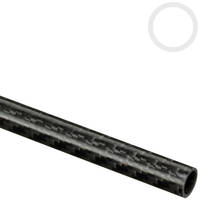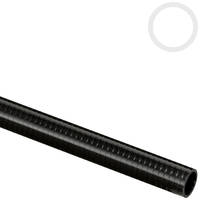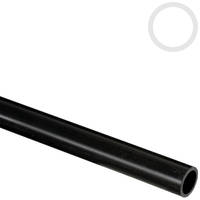Need any help or advice?+44 (0)1782 454499
PRODUCTS USED IN THIS PROJECT
Although not necessarily an exhaustive list, the following tools and materials, supplied by Easy Composites, were used in this project.
The quantity shown below is the approximate amount used in the project rounded up to the nearest available kit size or quantity.
MATERIALS & CONSUMABLES



VIDEO TUTORIAL
How to Choose the Best Carbon Fibre Tube for an Application
In this composites tutorial we take a deep dive into the world of carbon fibre tubes, discussing the different types, their construction, advantages and disadvantages. We compare carbon fibre tubes to each other, and also benchmark them against stainless steel and aluminium to see how carbon fibre tubes perform and compare in a range of tensile, compressive, torsional and 3 point bend tests.
TUTORIAL BREAKDOWN
1. The Different Types of Carbon Fibre Tube
There are two main types of tubes we are covering in this tutorial: Pultruded Tubes and Roll Wrapped Tubes.
Pultruded tubes tend to be in the smaller diameters and provide the maximum possible longitudinal strength but at the expense of being more vulnerable to crushing or torsional fracture. The inner and outer surface of these are smooth with the fibres visible if looked at closely. These tubes are formed by pulling the fibres through a resin bath and heated die to form the tube. The fibres are all orientated down their length. The pultrusion process does mean the tubes have a good level of stiffness but are easy to split.
Roll-wrapped carbon fibre tubes tend to be the larger diameters and - because of their alternating layers of reinforcement - produce a more resilient tube, especially to crush and twist forces. These tubes have fibres both down the length and around for hoop strength. They are formed by wrapping layers of pre-preg around a mandrel before being oven cured. They tend to have a smooth inner finish. The outer finish can be smooth or ribbed in finish. The ribbed finish is left from the manufacturing process. On our Woven Finish tubes this is ground off and the tubes lacquered for a high gloss finish. The roll wrapped tubes sacrifice a small amount of stiffness for hoop strength which gives them more all round strength and better crush and split resistance than pultruded tubes.
Other methods of tube construction include pull winding but includes additional helical fibres. Filament winding where fibres are wound around a mandrel, primarily for additional hoop strength such as in pressure vessels. Also tubes can be moulded using an outer mould and inner bladder, more commonly done for tubes with more complex shapes.
2. Mechanical Testing Introduction
The Purpose of these mechanical tests is to provide comparative data between the two types of carbon fibre tube, 304 Stainless steel and 6063 Aluminium. We are using the same profile sizes throughout the tests, namely 10mm outside diameter and 8mm inside diameter. This will show the performance relative to each other for identical profiles.
We are not working to any specific testing standards as there are not any that would work for all the materials and tests being done. Also we are not using standard SI units having converted to kilograms. This is to make the figures more relatable and informative for a lot of people watching. Many of the grips have been produced specifically for these tests so there will be some compromises to get the tests to work.
3. Tensile Strength Test
This is a simple tensile test where the tubes are pulled on until they fail. The tubes are pulled until their elastic limit and then further pulled until they break. The elastic limit is indicated by the constant gradient on the graph and when it begins to yield and move to plastic deformation, the gradient reduces until it breaks. As such the yield point is much more important to note.
The test is repeated for all the materials. With the carbon tubes, the failure is at the grip. This is a limitation of the grip method used which places a concentration of stress in that area, so with a better gripping method, much higher results would be expected. Had they not failed in this way, we would have expected the pultrusion to measure 3 times that of steel and 16 times that of aluminium.
4. Compressive Strength Test
This is a relatively simple compressive test pressing the tube between two grips. The metal samples behave pretty much as expected and the carbon tubes again fail at the grip showing the limitations of the test method. The steel tube is the best performer at 1.5 tons, followed up by the pultruded and roll wrapped tubes at just under a ton, with the aluminium tube failing at around half a ton.
5. Torsional Stiffness Test
We are comparing the tubes with a known torsional load to provide comparative data until the tubes slip in the grips or fail. It is particularly difficult to get a good grip in this kind of test to hold until failure, but we can test them to a known level. In this case 5 newton meters which is about what you can achieve with screwdriver, then continue until the grip or tube fails.
For each tube we tested how many degrees of rotation there was at 5 newton meters of load and continued until the tubes grip failed. Stainless steel performed the best, followed by the aluminium. Of the carbon tubes they both performed poorly with the roll wrapped tube slightly out performing the pultruded one.
6. 3-Point Bend Test
This is a flexural 3 point bend test for the tubes. Using custom tool heads to show elastic and finally plastic deformation and eventually failure. As expected, both the metal tubes failed through plastic deformation and bending. The carbon tubes deflected before failing through cracking and crushing of the tube. The roll wrapped tube performed the best at around 200kg followed closely by the steel tube at 175kg. The pultruded tube failed at around 140kg followed by the aluminium at 50kg. This test particularly highlights the benefit of the additional hoop fibres on a roll wrapped tube compared to the pultruded tubes.
When we take into account the weight and relative density of the materials, the balance of the results shift considerably. Stainless is nearly 5.5 times as dense as carbon at 8g/cm³ and aluminium nearly double at 2.7g/cm³. With the adjustment for weight, the steel and aluminium tubes perform similarly with the carbon fibre tubes now way ahead. Doing the same adjustment for the other tests, we see the same results for all except the torsional test.
7. Pultruded Tube Results & Considerations
In this section we consider the results and how it might influence the use of this type of tubes. In pure tensile and compressive loadings these tubes offer exceptional performance for their weight. Loaded down their length, these pultruded tubes are about as strong as a carbon tube can be but this is at expense of torsional performance, crushing and resistance to splitting.
This makes pultruded tubes ideal for applications such as arrow shafts, push pull rods, UAVs, kites, robotics and tent poles. They are also seen in embedding applications such as instrument necks and wing structures. As they are produced in a die, there is a reasonably accurate tolerance on OD and ID, however, if looking for telescoping sections, it is likely you will need to sand one tube smaller to get a snug fit.
8. Roll Wrapped Tube Results & Considerations
In this section we consider the results and how it might influence the use of this type of tubes. As seen in the tension and compression tests, these tubes perform almost as well as the pultruded. The three point bend test really did highlight the benefit of the hoop fibres and the crush resistance they offered over the pultruded tubes. It also highlighted how the hoop fibres do improve the torsional resistance slightly.
It is the additional hoop strength that means, although slightly weaker in stiffness, they offer better real world all round performance compared to the pultruded tubes. Being made around a mandrel, the inside diameter is most accurate with the outside dependant on how it is finished.
The woven finish tubes offer the best cosmetic appearance with the weave on show and high gloss finish. However the woven layer does also add to hoop strength and prevention of crack propagation and limiting of splintering. This makes them ideal for applications such as bicycle seat posts, camera equipment, ultra light aircraft, drone arms etc.
The none-woven roll wrapped tubes are still great performers but would likely be better suited to applications were cosmetics are not as important, or the benefits of the woven layer are not so critical. This could include tiller extensions, rowing oars, robotics, UAV arms or even window cleaning poles and similar applications.
9. Limitations of Carbon Fibre Tubes
Although the performance of carbon fibre tubes is very good for many applications, there are also limitations and uses where carbon fibre tubes may not be ideal or suitable. We shall cover some common examples here. A good example where carbon fibre may not be suitable is high temperature applications. Carbon fibre will severely deteriorate above 120°C. They are not suitable for applications involving high levels of abrasion such as sliding bearings and bushings where the surface will wear very quickly. Precision machining such as cutting of threads does not work well as the thread would be very weak - a better solution is to use a metal insert or similar with the thread in the metal for such applications.
Joining of tubes will need composite reinforcement or complex joining pieces making. Also it cannot be formed and will want to retain its current shape, so applications like bent handlebars etc would not be possible with premade tubing. However such tubes can be made as seen in this video; Laminating and Bagging a Carbon Fibre Tube Using a Split Mould.
Despite these limitations, carbon fibre tubes offer a high level of performance for the right applications and as such, Easy Composites offers a selection of different types and sizes of tubes suited for many applications.
DISCUSSION (7)
Please share any questions or comments you may have about this video tutorial.
They have the fibre orientation specifically orientated for torsional performance. These stock tubes do not. Compared to homogenous materials, composites are all about fibre directions and direction of loading.
Structural adhesive on a properly pre-pared surface works well. You can use a clamp type arrangement but bare in mind excessive clamping force may damage the tube.
Carbon fibre can be extremely good for making lightweight high-pressure vessels, you'll see a lot of tanks (such as hydrogen tanks) made either from pull-wound carbon fibre, or from aluminium wrapped in carbon fibre. In fact, there's a clip of this process included in this video when we mention pulwinding as another type of tube construction method. In terms of the tubes on test here, the pultrusions and the roll-wrapped, they are both designed for longitudinal stiffness, not to resist internal pressure. With no 'hoop' fibres, the pultrusions would be terrible for internal pressure. The roll-wrapped tubes which do have hoop fibres would fair much better but could be made much better by increasing the amount of fibre in the hoop direction.
It's almost always a case of bonding an insert (often of metal but could be various materials) to the tube and the fixing to the fitting. The key with carbon fibre tubes is to keep the fibre continuity intact as much as possible.
It's generally a case of bonding inserts into, or onto, the carbon fibre tube and then linking the inserts. Composite joining sections are an option but are very expensive (due to the huge complexity involved in making them). You can also bond smaller or larger tubes inside or outside of the main tube to sleeve or ferrule them where you need additional strength.
Carbon is not great with abrasion so a sliding bearing would fairly quickly cause it to wear.
Braided sleeving can be used and will perform similarly to woven materials depending on the position of the fibre orientation
LEAVE A COMMENT OR QUESTION
PRODUCTS USED IN THIS PROJECT
Although not necessarily an exhaustive list, the following tools and materials, supplied by Easy Composites, were used in this project.
The quantity shown below is the approximate amount used in the project rounded up to the nearest available kit size or quantity.
MATERIALS & CONSUMABLES



DISCUSSION (7)
Please share any questions or comments you may have about this video tutorial.
They have the fibre orientation specifically orientated for torsional performance. These stock tubes do not. Compared to homogenous materials, composites are all about fibre directions and direction of loading.
Structural adhesive on a properly pre-pared surface works well. You can use a clamp type arrangement but bare in mind excessive clamping force may damage the tube.
Carbon fibre can be extremely good for making lightweight high-pressure vessels, you'll see a lot of tanks (such as hydrogen tanks) made either from pull-wound carbon fibre, or from aluminium wrapped in carbon fibre. In fact, there's a clip of this process included in this video when we mention pulwinding as another type of tube construction method. In terms of the tubes on test here, the pultrusions and the roll-wrapped, they are both designed for longitudinal stiffness, not to resist internal pressure. With no 'hoop' fibres, the pultrusions would be terrible for internal pressure. The roll-wrapped tubes which do have hoop fibres would fair much better but could be made much better by increasing the amount of fibre in the hoop direction.
It's almost always a case of bonding an insert (often of metal but could be various materials) to the tube and the fixing to the fitting. The key with carbon fibre tubes is to keep the fibre continuity intact as much as possible.
It's generally a case of bonding inserts into, or onto, the carbon fibre tube and then linking the inserts. Composite joining sections are an option but are very expensive (due to the huge complexity involved in making them). You can also bond smaller or larger tubes inside or outside of the main tube to sleeve or ferrule them where you need additional strength.
Carbon is not great with abrasion so a sliding bearing would fairly quickly cause it to wear.
Braided sleeving can be used and will perform similarly to woven materials depending on the position of the fibre orientation
LEAVE A COMMENT OR QUESTION
100% SECURE
PAYMENT METHODS
Easy Composites EU B.V., registered in the Netherlands 73601195. All content copyright (C) Easy Composites Ltd, 2025. All rights reserved.